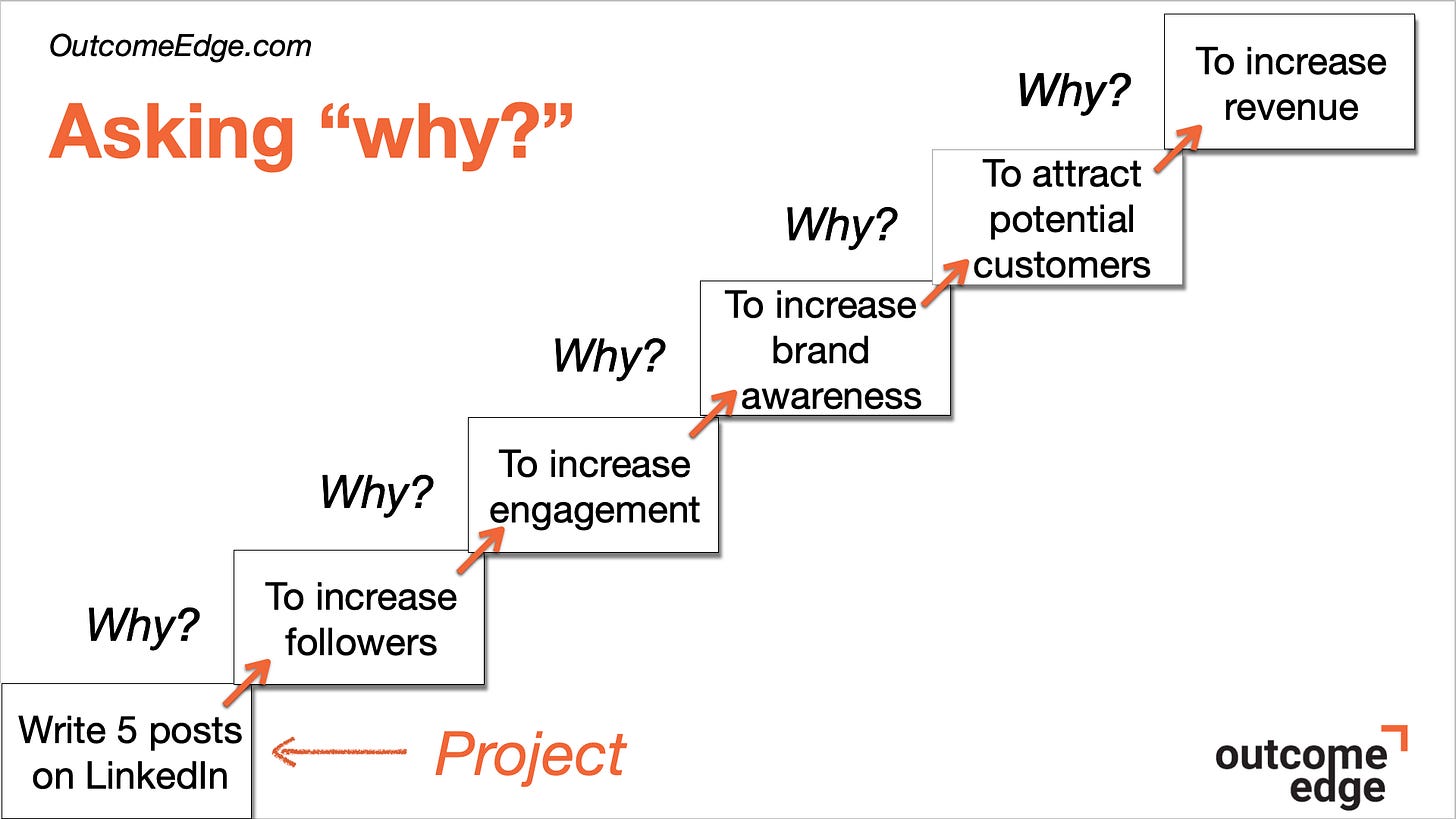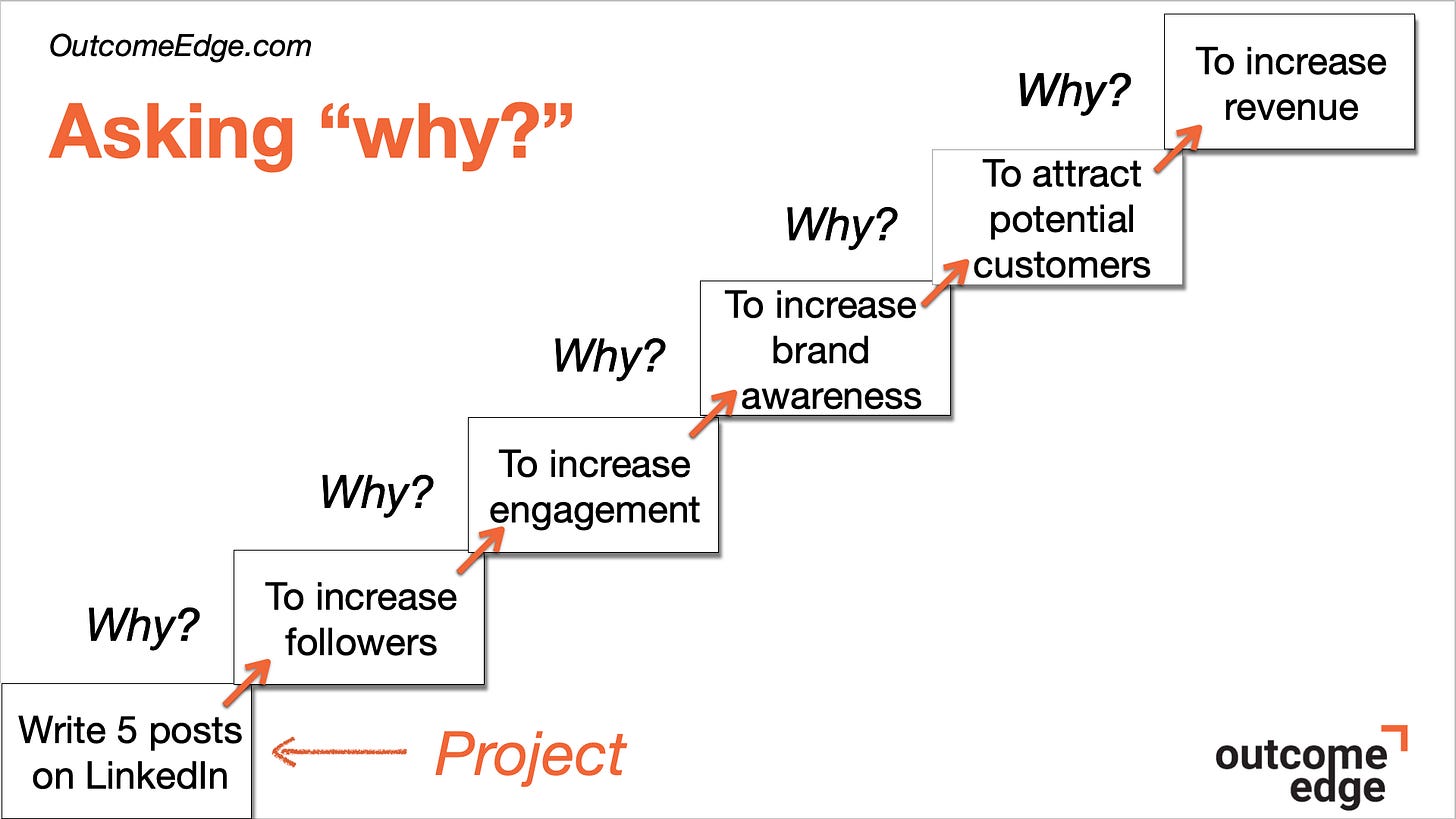Build your outcome muscles by asking "why?"
Using the Five Whys technique to shift from projects to outcomes.
We've been talking about the need to develop your outcome muscles for a while. In today's article, we'll see how you and your team can strengthen those muscles with an exercise I use with my clients.
If this is your first time reading my newsletter, please read this article and this one before continuing. Today's post builds on concepts discussed in them.
This post is also available in Portuguese.
As we’ve seen, we need to begin with the end in mind and start by clearly defining our desired outcome.
But you probably already have projects planned or under way. What should you do with them?
And what should you do if you or a coworker gets stuck thinking about a project?
Asking “Why?” repeatedly can help teams shift from projects to outcomes. It’s a great exercise to develop outcome muscles and unlearn old mindsets and behaviors, if properly used.
For a simplified example, imagine that a marketing analyst reached out to her manager asking for help:
-I created a Key Result that says, “Write 5 posts on LinkedIn,” but now I know that’s a project, not a real Key Result. Can you help me identify the outcome?
-Why do you want to write 5 posts on LinkedIn?
-To increase followers.
-Why do you want to increase followers?
-To increase engagement.
-Why do you want to increase engagement?
-To increase brand awareness.
-Why do you want to increase brand awareness?
-To attract potential customers.
-Why do you want to attract potential customers?
-To increase revenue.
Asking “why?” multiple times helps map a sequence of outcomes that “ladder up,” connecting the original project with a top-level outcome:
This technique is called the Five Whys. It comes from Lean Manufacturing, where it's used to identify the root cause of a problem.
We’ll use a slightly different version focused on helping teams identify their desired outcomes and connect their work to the company OKRs.
Outcomes are like a sequence of dominoes
Imagine a sequence of dominoes, where knocking over the first piece creates a chain reaction, sequentially toppling each domino until the last.
Instead of viewing outcomes in isolation, it's best to see them as a cascading sequence, like a series of falling dominoes.
When defining our desired outcomes, we want to intentionally select the ones that build on each other, creating a powerful domino effect.
Looking at our example again, we can see that we answered each “why?” question with a clear outcome. Each item in the sequence contains a measurable benefit we want to create:
This sequence of outcomes works like a series of dominoes, where achieving the first outcome contributes to achieving the second, and so on, until we reach the company's desired outcomes.
The Five Whys can be a great coaching tool
Teams need guidance, coaching, and support from their managers to perform at their best. And the Five Whys can be a great tool to coach and develop the teams.
People often understand why they’re working on a project but struggle to express the outcome. The Five Whys technique can help identify those outcomes.
But if a team is struggling to answer even the first “why,” it means they lack the basic understanding of the context they need to focus on outcomes. Leaders have to step up and fix this by coaching the teams.
Asking “Why?” is just the first step
Asking “Why?” is a great start, but to focus on outcomes we can’t stop there.
Going back to our first example, the marketing manager continues coaching the analyst after mapping the sequence of outcomes shown in the image above:
-Now we need to select the outcomes you will focus on. At which "level" of the sequence do you think you should focus?
-Increasing followers sounds nice, but that's irrelevant without building relationships with potential customers. I'll focus on attracting potential customers.
-How can you measure this outcome? Which metrics could you use?
-I can measure the number of people who contact us to book a demo of our software or the number of qualified leads.
-What other ideas could you test to achieve this outcome? We want to focus on the outcome instead of getting stuck on a single project.
- We can experiment with different things, for example: publishing interviews with reference customers, running small online events, and making a better product demo video.
Example two
For another example, imagine a product team having this conversation:
-We are building a new customer service tool, but we're struggling to define the intended outcomes. Let's use the Five Why's technique.
-Why are we building a new customer service tool?
-To make the tool easier to use.
-Why do we want to make the tool easier to use?
-To help customer service agents find the information they need faster.
-Why do we want to help agents find the information faster?
-To solve customer issues faster.
-Why do we want to solve issues faster?
-To improve customer satisfaction.
-Why do we want to improve customer satisfaction?
-To increase customer retention.
-Here's the sequence of outcomes we have mapped. Which of these outcomes should we focus on?
-In the end, we want to increase retention. However, many factors affect retention, so we may never know if our team made a difference.
We could create a shared OKR with the customer service team to solve issues faster, but measuring our contribution might be hard.
Let’s focus on the two outcomes at the beginning of the sequence: “make the tool easier to use” and “help agents find information faster.”
-And how can we measure these outcomes? Which metrics could we use?
-We could measure the completion rate of common tasks, the time to complete those tasks, and the time to retrieve the necessary information.
-What other ideas could we test to achieve this outcome?
-We can test different ways to train customer service agents on using the tool.
But the key point is that we can't treat the development of the tool as a project with predefined features. We have to experiment with different ideas or approaches to achieve the outcomes we've selected and test those ideas with real users.
If you are always starting with a project, there's something wrong
The Five Whys is a powerful tool for helping teams develop their outcome muscles and mindsets, but it's often used as a temporary technique during the transition to outcomes.
As teams become more fluent at beginning with the end in mind (i.e., defining desired outcomes from the start), they naturally tend to rely less on this technique.
Using the Five Whys technique occasionally is fine, but if you always start with a specific project, that's a red flag.
Some process or tool in your organization may be forcing you to define specific projects before identifying the desired outcomes. If this is a recurring pattern, it's time to review your current practices.
You may need to unlearn or rethink some of them.
Using the Five Whys in practice
Here are a few tips:
Answer each “why?” with a clear outcome
You have to answer each “why?” question with a clear outcome: the measurable benefit you want to create, as we did in the examples above.
Learning to communicate your desired outcomes using clear language is one of the muscles you have to develop, so take the opportunity to practice this.
The real challenge is mapping the middle of the sequence
Usually, the real challenge is identifying the outcomes in the middle of the sequence. Don't give up easily: working on defining those outcomes will be a great exercise.
If you jump straight to the top-level outcome without identifying the ones in the middle, you are doing it wrong.
You don’t have to ask “why?” five times
You don’t have to ask “why?” exactly five times. Many teams do it in four or six steps, for example.
But the whole point is to ask “why?” a few times and map a sequence of outcomes. If you only ask “why?” once and stop at the first outcome you can find, you are doing it wrong.
The sequence of outcomes doesn't have to be a single line
I've used a single line of outcomes in my examples to keep things simple. However, you may find cases where one "why?" question leads to multiple outcomes, creating a "fork in the road" in the sequence:
The Five Whys can help you unlearn old mindsets
Seeing people use the Five Whys technique reminds me of the corrective exercises my physical therapist taught me.
Corrective exercises are physical activities designed to not only strengthen muscles, but also retrain the body to move in a healthier way. They help address muscle imbalances, improve posture, and restore proper movement patterns.
Corrective exercises help unlearn bad habits and behavior patterns that can cause pain or injury.
And that's what the Five Whys can do for you.
If properly used, it can be a great corrective exercise to help develop your outcome muscles and unlearn old mindsets at the same time.
Now it's your turn to use the Five Whys
The only way to develop your outcome muscles is through a lot of practice, so now it's your turn to use the Five Whys.
In my experience, the best way to do this exercise is to form a group of three to six people who work together and have them use the Five Whys on a real example.
Take a real project that you are working on or have already planned, and then go through the steps below.
Ask “why?” five times (or as many times as needed). Answer each “why?” with a clear outcome.
Then, use each answer as the basis for the next “why?” question, mapping a sequence of outcomes.
Looking at the sequence of outcomes, select the one(s) you will focus on.
How can you measure the selected outcome(s)?
Which metrics could you use? Do you need to create new metrics or use different ones than you typically do?
What other ideas could you test to achieve the selected outcome(s)?
Feel free to share your experience and insights from the exercise in the comments or via email. I’ll be back soon with another post.
If you’re finding this newsletter valuable, share it with a friend and consider subscribing if you haven’t already.











